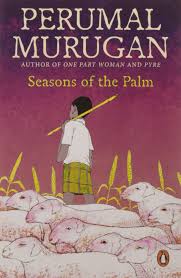Godan of South India
Seasons of the Palm by Perumal Murugan
I have heard about Perumal Murugan during the peak of controversy of his novel Madhorubhagan (One Part Woman) when he said in responding to controversy to his book, “Perumal Murugan the writer is dead.” So, I picked up the three of his books and this one, which was shortlisted for Kiriyama Prize, was the first one I have read.
This book is almost plot-less. It is about the journey of Shorty and his group of untouchable kids who worked as household help to different high caste landlords in Tamilnadu. Reading this book is like looking at a imagery the author had created and submerging in the feeling his words evoked. So, unique is the imagery, narrative, and the thought of the characters that you feel that you are watching or participating in their activities. Five characters, all children of different age, uniquely named, Shorty, Stumpleg, Belly, Tallfellow and Stonedeaf, had been called with the choices of abuses directed towards their caste by their landlords. Shorty, the protagonist, lives with sheep like a family, away from his own family, as he calls/recalls the sheep with the names and their personalities, which he has given to them. All of them work as shepherd. In addition, the primary work of Tallfellow is to clean shit of his old master whose family doesn’t take care of him. Stonedeaf carries the baby of a high society women (an unheard thing for a untouchable to do) around as she couldn’t take care of her because of her health. In a nutshell, they all are like kids who are trying to squeeze out some childhood in severely punishing circumstances from where there seemed to no exit. Anyone who tried to get out of the bondage returns on their own (owing to debt of their parents or knowing that household helps are completely replaceable) or brought back by their landlords or killed. The author shows the contrast by bringing the landlords’ sons into the book, who despite their age, the reader will feel how much they have imbibed the authoritarian and castiest attitude of their parents.
The book can be tad boring if you have come to expect that the book will go at a speed of detective/thriller novel. You could keep reading this book and yet you can reach nowhere in term of real closure, maybe the author doesn’t want to provide any closure to the narrative. The chapters in the book sometime ends abruptly and the next chapter starts with something new and the author resolve some of the earlier chapters later in the book. If you are accustomed to reading otherwise, you might feel a little awkward reading this book.
Overall, it seems that the book fails to provide a conclusion but the book paints the picture of a castiest society, oppression, feudalism that exist in Tamilnadu. More so, this novel evoke the feeling of Premchand’s novel Godan, suggesting that all of the things that existed in Premchand’s time still exist in Perumal’s time.
